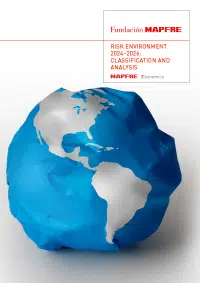Home > MAPFRE Economics >
Studies
Reports related to research projects carried out by MAPFRE Economics. These are reports of a technical nature whose aim is to share ideas on different topics related to the economy, the financial system and the insurance sector.
Reports related to research projects carried out by MAPFRE Economics. These are reports of a technical nature whose aim is to share ideas on different topics related to the economy, the financial system and the insurance sector.

Demographics: an analysis of their impact on the insurance business
Major demographic trends and changes in the population structure are key aspects in the strategic design and performance of the insurance sector at a global level. Birth rates, mortality rates, life expectancy, migratory movements and their impact on the work force determine the demographic trends and behavior patterns that have the greatest impact on the development of those sectors of the economy related to insurance activity. This report studies these demographic factors and their economic impact in the main regions of the world, as well as for a group of eight specific countries. The aim is not only to confirm the global nature of these phenomena, but also to highlight the particularities of these demographic processes and their economic impact in different contexts. Furthermore, in order to summarize these demographic trends and generalize the analysis to a global level, the report proposes a relative measurement indicator for insurance potential based on the demographic impulse, estimated for a universe of 179 countries.
Demographics: an analysis of their impact on the insurance business (English)
Demographics: an analysis of their impact on the insurance business (Spanish)

Risk environment 2024-2026: typology and analysis
The preparation of plausible economic forecasts and scenarios depends both on the control of economic logic under normal conditions, and on the understanding of the risk elements that could transform a central vision into a less probable alternative vision with a higher socioeconomic cost. Thus, the conceptualization of risks is an exercise linked to dynamics of a social, economic and political nature, which, in turn, are conditioned by the context they are generated in and are at the mercy of eventual catalysts of change. This report proposes a general conceptual framework that explores common views on these determinants in the process of considering the risk environment, analyzing the socioeconomic risks that would affect the central scenario with greater depth and probability, while exploring the geopolitical risks the world is facing.
Risk environment 2024-2026: typology and analysis (English)
Risk environment 2024-2026: typology and analysis (Spanish)

Insurance solvency regulation systems outlook
Over the last few decades, financial system regulation has been subject to a continuous process of adjustment, the common denominator of which has been the move towards risk-based schemes. Based on the analysis of the characteristic regulatory frameworks in various regions of the world (United States, Latin America, Asia-Pacific and the European Union), as well as global initiatives in this field, the study analyzes the prudential regulations applicable to insurance entities and their groups since the last assessment made in the version published by MAPFRE Economics in 2018, in order to incorporate the progress made since then in the move towards risk-based regulation. Also, from a public policy perspective, the report elaborates on the set of institutional and market preconditions that it is desirable to meet in order to achieve further progress in the implementation of risk-based regulations in the insurance sector.
Insurance solvency regulation systems outlook (English)
Insurance solvency regulation systems outlook (Spanish)

Global savings and insurance industry investments
The insurance business model makes it necessary to implement liability-driven investment strategies in order to achieve an adequate match in time horizon, currencies and interest rates between the liabilities assumed and the investment instruments backing them. In doing so, insurance companies support the investment process in the economy through a stable flow of resources that provides long-term financing and contributes to the stability of the financial system. Within this framework, the report provides a general assessment of the recent evolution of global savings, as well as an overview of the distribution and risk profile, according to asset type, of the investment portfolios of insurance companies in select markets in major global regions. It also includes an analysis of the investment portfolios of selected international insurance groups, including information on the credit rating of the portfolios in which they invest.
Global savings and insurance industry investments (English)
Global savings and insurance industry investments (Spanish)

Real estate markets and the insurance sector
Real estate activity is an area of particular interest to the insurance industry, insofar as it is linked to a wide variety of risks. Thus, based on the main interconnections between the insurance sector and the residential real estate market, the report analyzes the ties between the two in a set of reference countries. It also proposes a relative measurement of the insurance sector’s potential derived from the dynamism of the real estate markets for a universe of 43 countries, based on the construction of the Real Estate Potential Indicator for the Insurance Sector, which aims to assess the relative capacity of the insurance sector to transform the momentum of the real estate market into new insurance demand.
Real estate markets and the insurance sector (English)
Real estate markets and the insurance sector (Spanish)

Global savings after the pandemic and insurance industry investments
This report updates the information contained in the reports on the distribution and risk profile of the investment portfolios of insurance entities that MAPFRE Economics has been preparing since 2018, for a selection of markets in major regions globally. The report also includes an analysis of the investment portfolios of a selection of large European insurance groups, which incorporates information on the credit rating of the portfolios in which they invest. In addition, this version of the report includes a preliminary analysis of global savings in the aftermath of the Covid-19 pandemic, which provides an overview of the main factors that have affected it during the health crisis, from the perspective of both developed and emerging economies, making it possible to register the relevance of the insurance sector as one of the main drivers of savings and, consequently, medium and long-term institutional investors.
Global savings after the pandemic and insurance industry investments (English)
Global savings after the pandemic and insurance industry investments (Spanish)

Covid-19: a preliminary analysis of demographic and insurance industry impacts
The report provides an assessment of the demographic impact of the Covid-19 pandemic, particularly on mortality. Based on data from 15 selected countries in the Americas, Europe and Asia-Pacific, the study presents an estimate of excess mortality during the first two years of the pandemic. It also offers a review of the interrelationships between excess mortality and other economic and health variables, and proposes a “Pandemic Management Effectiveness Indicator” which, using a synthetic index, groups together the combined effect of all these variables for a universe of 39 countries.
Covid-19: a preliminary analysis of demographic and insurance industry impacts (English)
Covid-19: a preliminary analysis of demographic and insurance industry impacts (Spanish)

Using the conceptual framework based on the risks that pension systems are exposed to (proposed in the 2017 MAPFRE Economics report), this study updates the review of the six models that were analyzed then (Chile, United States, Spain, United Kingdom, Sweden and the Netherlands) and includes five new models (Brazil, Germany, France, South Korea and Japan). Further, the report includes the Retirement Pension System Pressure Indicator (“Indicador de presión sobre los sistemas de pensiones de jubilación” or IPSPJ in Spanish), developed by MAPFRE Economics for 45 countries, which helps to assess the degree of pressure said systems are exposed to, to begin their restructuring. Using this international comparison analysis as the foundation, the report provides a combination of public policy elements in order to make pension systems sustainable and stable in the medium and long term.
A global perspective on pension systems (English)
A global perspective on pension systems (Spanish)

This report provides a general overview of the development, distribution and risk profile of the assets in the investment portfolios of various insurance entities in several developed markets (Eurozone, United States, Japan, United Kingdom, and Spain) and emerging markets (Brazil and Mexico). Further, the study includes an analysis of investment portfolios from a selection of large European insurance groups, which takes into consideration information regarding the rating of the portfolios said Groups invest in. This report is especially relevant considering that the insurance sector is one of the largest institutional investors globally, and as such, contributes to capital formation through a stable flow of resources for long-time financing for projects that promote economic growth, and support the stability of the financial system by providing the economy with a mechanism that reduces procyclicality in times of crisis.
Insurance industry investment (English)
Insurance industry investment (Spanish)

Life insurance not only offers personal protection and compensation for the risk of death and other retirement-related risks, but it also provides a stable inflow of resources for financing productive medium and long-term projects, giving the economic system an important anti-cyclical stabilization tool.
This report includes a comparative analysis of international Life insurance experience, and the mechanisms that have been used for this product to become a public policy tool for stimulating savings, especially in the medium and long-term. It provides a detailed view of the wide range of product types available in the markets that have been analyzed, according to a classification that groups them into five major categories: protection, savings, investment, annuities and retirement-specific products. There is a global analysis, as well as a specific study of a selection of representative markets covering the United States, Mexico, Brazil, Spain, the United Kingdom, Italy, Japan and Hong Kong.
Elements for the development of life insurance (English)
Elements for the development of life insurance (Spanish)
Elements for the development of life insurance (Portuguese)

This report, which aims to give an up-to-date perspective of the markets, products and population that microinsurance is geared toward, has been carried out within the framework of the MAPFRE Sustainability Plan 2019-2021, which includes a line of work referring to “Financial/insurance education and access to insurance”.
Financial inclusion in insurance (English) (.PDF, 7,4 MB)
Financial inclusion in insurance (Spanish) (.PDF, 5,59 MB)

This report provides a comparative view of the distribution of insurance entities’ investments by asset type in a selection of markets, including four of the world’s largest (Eurozone, United States, Japan and United Kingdom), as well as Spain, Brazil, and Mexico. Presenting information from 2008 to 2018, traditional investment portfolios (in which the investment risk stays on the insurance entities’ balance sheets) was distinguished from investments where the policyholder bears the risk, wherever possible. The study is completed with an analysis of the 2018 information regarding the investment portfolios of six large European insurance groups with global operations, and a comparison of the applicable gross capital charges required for the most representative investment portfolio categories of the insurers using the Solvency II standard formula.
Insurance industry investment (English)
Insurance industry investment (Spanish)

Population aging
The report offers a reflection on the impact on the economy and on social security as a result of the aging of the population, proposing that the rising age of the population could be one of the factors behind the trend toward greater financial interdependence, secular stagnation, and economic inequality. Likewise, the study takes on the primary effects of the demographic transition on the maintenance of the health and pension systems.

Health systems: a global analysis
This study analyzes a selection of health systems in different regions of the world, including models that incorporate some feature differentiating them from the others and that can be used as a reference when designing public policies related to healthcare systems. It also proposes an indicator of the effectiveness of health systems, which has been estimated for a total of 180 countries and makes it possible to obtain a comparative global view of those systems.
Health systems: a global analysis (English)
Health systems: a global analysis (Spanish)
Health systems: a global analysis (English) (ePub)
Health systems: a global analysis (Spanish) (ePub)

Insurance industry investment (edition 2018)
This report analyzes the dimension and role of the insurance sector as a relevant and stable investor for financing economies. In order to have a representative group of markets, the kinds of assets insurers invest in, in what proportions, and the variations thereof in the last decade have been studied. It is shown how investment decisions depend in large part on the need for asset and liability matching, on capital charges from solvency regimes and on their intrinsic risk.
Insurance industry investment (English)
Insurance industry investment (Spanish)

Insurance solvency regulation systems
Insurers and their groups are entities that, without exception, due to the key role they play in the workings of the financial system and of economic activity in general, are subject to systems of prudent regulation. In this context, the recent financial crises have opened a process of progressive and asymmetric convergence towards risk-based regulations on a global scale. This study analyzes the progress of this process, and the complexity associated with it, taking into account the outlook in large, mature markets like the United States and the Eurozone, as well as in other emerging markets like Latin America and Asia-Pacific. This report also deals with the efforts the International Association of Insurance Supervisors (IAIS) is making in the development of globally consistent supervision frameworks for large international insurance groups.
Insurance solvency regulation systems (English)
Insurance solvency regulation systems (Spanish)
Insurance solvency regulation systems (English) (ePub)
Insurance solvency regulation systems (Spanish) (ePub)

Pension Systems
The main objective of this research is to help diagnose one of the most important pillars of today’s social organization, pension systems, by emphasizing the risks which they are exposed to and identifying the elements that can contribute to their long-term sustainability and stability.
Pension Systems (English)
Pension Systems (Spanish)
Pension Systems (English) (ePub)
Pension Systems (Spanish) (ePub)

Elements for the expansion of insurance in Latin America
The main objective of this study is to analyze the key determinants of the level of insurance penetration in Latin America, in order to outline the general lines that could be considered in the design of public policies whose aim is to increase their penetration in the economies of the region. Thus, the conceptual framework used in the preparation of this work has been focused on the analysis of the main factors that can boost the penetration level (premiums / GDP) from the point of view both of the offer (factors that affect the creation of insurance services), as well as the demand (factors that explain the intensity of consumption of those services).
Elements for the expansion of insurance in Latin America (English)
Elements for the expansion of insurance in Latin America (Spanish)
Elements for the expansion of insurance in Latin America (English) (ePub)
Elements for the expansion of insurance in Latin America (Spanish) (ePub)
